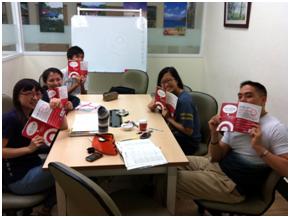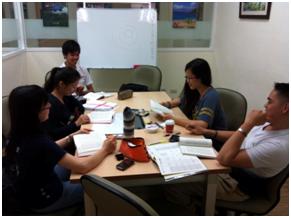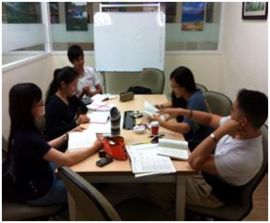小小綜合國領導團讀書會
出自KMU Wiki
目錄 |
[編輯] 一、作者簡介
- 賽門˙西奈克 Simon Sinek
樂觀信念者、激勵型演說家,專門協助各級領導人和組織如何啟發、感召別人。從國會議員到聯合國大使,從中小企業到微軟、英特爾、3M、美國運通等跨國企業,從好萊塢到美軍,只要是希望擁有啟發、感召能力的人,都希望深入了解「黃金圈」(The Gloden Circle)及「為什麼?」(Why)的威力。西奈克為多產作者,定期為《紐約時報》、《華爾街日報》、《華盛頓郵報》、美國《商業週刊》等知名報章雜誌撰寫專欄。目前於哥倫比亞大學教授「策略溝通課程」只要沒有出外演講,西奈克通常住在紐約。
[編輯] 二、本書摘要
所謂做事的原則就是探究中心的思想,本書教導我們如何成為一個好的領導者或一個好的企業,應該有怎樣的思維與執行力。這原則從簡單的幾何圖作說明,也就是本書作者,Simon Sinek發明的「黃金圈」。三個同心圓由內而外,分別為「為什麼(why)、如何做(how)、做什麼(what)」,簡潔有力的涵蓋整本書所要表達的內容,並與人體的大腦結構做醫學生理的結合,「為什麼=緣腦,新皮質=怎麼做」,讓我了解到不單單只是無中生有理論而已還結合科學的知識。成功的企業與讓人願意追隨的領導者,他們在許多的處事方面,這本書竟然巧妙地以黃金圈作完美的結合。這是一本值得大家一在閱讀並推薦周遭朋友的好書。
[編輯] 三、佳句摘錄
- Part 1 不探究「為什麼」的世界
- 資訊多,不見得一定有幫助,尤其當整個流程是根據錯誤假設開始時。我們還必須考慮其一些其他因素,他們存在於執掌理性分析、渴求新知的腦袋之外。
- 真正的創新,能夠徹底改變產業,甚至整個社會,諸如電燈泡、微波爐等,這才是真正的創新。
- Part 2 另一種選擇
- 如果凡事都從”為什麼”開始,我們每個人都能獲得更大的成就。
- Part 3 領導的本事
- 他們相信自己一定做得到,同時更信任自己的團隊,放手讓同仁全力發揮。
- Part 4 激勵群眾的力量
- 悲觀主義者的看法往往是對的,然而,真正改變世界的,卻是樂觀主義者。
- Part 5 成功是最大的挑戰
- 成就感是永無止盡的追尋。當我們每天早上醒來,追求的都是做什麼背後的為什麼時,成就感就會油然而生。
- Part 6 發現為什麼
- 賈伯斯說:「我希望在宇宙留下一點刻痕。」
- 亨利∙福特曾說:「無論你認為自己做不做得到,你都是對的。」他是聰明絕頂的人,也是典型為什麼型的人。
- 當你和別人競爭時,沒有人會幫你忙,但當你和自己競爭時,每個人都願意拉你一把。
[編輯] 四、心得感想
- Part 1 不探究「為什麼」的世界 ─ A world that doesn’t start with “why”
一開始,提到我們做了一個假設,在提供一些讓我們做判斷的資訊下做的假設,但這個假設是謬誤的,怎麼會呢?他的開頭說明我們在做判斷與分析時,往往是根據自己的認知與「自以為」的想法,這樣的結果造成的是一個錯誤的開始。
書中舉例,製造汽車的公司,一家是美國車廠,另一家是日本車廠,兩者都是製造汽車,但製造車門的方式不一樣。日本車門的吻合度,在設計汽車圖時就已經謹慎的規畫好了;美國汽車則是在汽車設計好後,雇用一群工人來敲打車門,每台車的車門多做一道敲擊車門的手續,使車門的吻合度提高。雖然車門的吻合度都提高,但美國如果在一開始就規劃好汽車車門形式,就不用雇用那批員工與購買那些鐵鎚。
「萬事起頭難」就是最佳的描述,長期的成功始於源頭,所以在做任何計畫或作為一個領導者,必須明確知道從哪一步開始,而這一步是慎重且正確的,不然造成的後果只會是一步步走入深淵,並無法見藍天白雲的。
領導人使用的策略也是一樣,而影響人類行為的策略有兩種方法,操作與感召。好的領導人是會善用這兩種方法,如果使用不當可能會像是市場使用的價格戰,一片廝殺慘烈的紅海市場。「領導是要讓人中心追隨,無論高山低谷,追隨者甘之如飴。」領導人是要能感召他的追隨者,使追隨者對領導者產生忠誠度,如書中舉例,蘋果雖然在電腦使用者只占2.5 %的市場,卻非常優秀,因為她有一群愛好蘋果的忠實粉絲。
In the beginning, the book mentioned that we made assumptions, even when the information is provided. But what if these assumptions are false?Simon Sinek, the author begins by explaining our judgment and analysis, often based on self-cognitive point of view that results with mistakes.
The examples the book mentioned are two automobile manufactures, one in USA and the other one in Japan. Although the end product seems to be identical, it’s the door manufacturing process that makes them different: The doors for the Japanese cars are already fitted and planned when the Japanese manufactures designed the cars. On the other hand, the American manufactures hires an extra group of employees to adjust the car doors to fit efficiently after the cars are already designed. This means additional process to fit the door on every car just to improve the goodness of fit. Perhaps the doors for fitting does increased in the end, but if the American manufactures designed a better car door in the beginning, it’d save the time and money to hire extra employees and hammers to fit the car doors manually in the end.
As the old saying goes, “Everything is hard in the beginning” and all long term successes start with the first step. So while planning or as a leader, you must know exactly where to make the first step, and this step is crucial and sure, otherwise the consequences will only be worse as you proceed without seeing the results you’ve expected.
The strategies applied by the leaders are the same, while two strategies that affect human behaviors; the controlling and inspiring. Good leaders can and will utilize both strategies, though false practice may lead to the “pricing war” in business and lead towards the competitive market. “True leader inspire their followers, regardless what situations may be, followers are willing to support their leaders.” Leaders not only can inspire the followers, they can also make followers loyal to them. For example, Apple may only have 2.5% market share in the overall computer users worldwide, yet the track record is phenomenon because of its loyal Apple users. (陳羿霈)
- Part 2 另一種選擇 ─ The Alternative Choice
書中提及影響人類行為的方法有操作與感召兩種,就好比我們從小就會對我們身邊的人說「我會當你最好的朋友」來與旁人談判,或從同伴手中取得自己想要的東西。這讓我思考了一下現今社會上的消費行為好像真的不會離這兩個模式太遠:百貨公司或店面推「破盤出清」、「老闆不要命」,以低價吸引消費者來花錢;以許多眼花撩亂的促銷花招來獲利;用使人恐懼的心理的操作手段來挑動顧客的不安全感,以期望販賣更多商品;針對人類生來就具有的「渴望」心態為重心來煽動消費市場;甚至最常見的,是將產品營造出大家都在使用,或是Jordan在使用的方式,營造出一種不能落後同儕的壓力來影響消費者。這些模式就如同文章的標題一般,賣家以胡蘿蔔和棍子來影響消費者的消費行動!但書中提及一個很棒的概念是-操作創造不了忠誠度。操作讓買家與賣家皆須承受著壓力,而且與多一時操作有用的方式,卻不一定代表是正確的。
過去我們認為市面上的賣家都是因為買家有需求,因此而設計產品或創意發想以滿足我們所想,也一直覺得這樣的模式是現今相當理所當然的事情。因此在讀完這一個第三章的確讓我嚇了一跳!作者一直在書內提及黃金圈的概念,也就是本書的軸心-先問「為什麼」。作者認為如果我們凡事都先從為什麼開始,則大家都能夠或到更大的成就;這句看似簡單的話,也相當有邏輯,也覺得一般大家都是這樣吧?但仔細想過才發現,市面上的買家都是先想到做甚麼(買家的需求),在想怎麼做,進而才有為什麼這般做的答案。我自己本身是Apple的愛用者,自己喜歡的理由當然是好用、有型等大家都知道的答案,但書中卻告訴我們蘋果的商品是信念具體的結果-他們的為什麼:挑戰現況。他們無論做甚麼產品、進軍哪個行業都秉持著「不同凡響」!這才讓我了解到為什麼支持蘋果的原因,也才發現,當一個買家打從內心秉持且堅持自己的信念時,世界會有人被你感動且支持你的!
In the past, we used to assume that suppliers exist because there’s a demand and buyer on the market, thus the products and innovations are only there to fulfill what we thought of, and agree upon how the systems works even ‘til this day. But my understandings totally changed after reading part 3 of the book!
Simon Sinek continues to mention the concept of “Golden Circle” as the core of this masterpiece, first start with “Why?” He explains that, if people all do and think from the “why” first, then perhaps everyone will achieve greater and accomplish more; easy saying, but with some hidden message and logic theory behind it.
Yet as you think it through, most consumers think about what they need as the priority, then how to do it, and finally comes to why they should do what they do as the answer. Point to taken, I’m a heavy user for Apple’s product, and the same reason for liking it is great user experiences, stylish, all those answers that you’d get when asking the others. But the book explains how Apple’s product all deliver the same message, as the core value and the “Why”: “Challenging the Status-Quo” It is the same philosophy they all abide of, “Think Different!” and made me realize then that is the reason why I use Apple’s product instead of others. It is the same principle I discovered, that when a consumer believe and support its own value, somewhere in the world there will be people believe in your vision and support you! (陳怡碩)
- Part 3 領導的本事 ─ Potential of Leaders
一直以來媽媽與外婆都告訴我「絕對不要樹立敵人;人生中最重要的資產莫過於朋友」這樣的人生價值觀,而我也一直銘記在心,而在讀完後發現書中的觀念與媽媽、外婆的經驗完全不謀而合。本書的作者提及:「信任才是成功的基石。」我想,除了在人生道路上也是這樣的概念之外,在工作上找到對的人、相信夥伴,並且為相同的理想、目標來努力更是達到成功的屢試不爽的方法吧。
在過去管理工作的課堂上,老師也與我們分享到,要找到對的人在一起規劃藍圖,而非先有藍圖才嘗試找對的人;這些長輩的經驗談都指向同一個理念,這也更讓我對於這樣的價值有更深的認同感。我想1+1的力量絕對是大於二的,但究竟多大,則要源自團隊中共同的力量:相信自己做得到,也同時信任自己的團隊,讓每個人都能夠盡自己所能地發揮的緣故吧!
“Never make enemies; the most valuable assets in life are friends!” This is the family value my mother and grandma always tell me since childhood. But the family value I abide with all my life became a contrast when I get to read this book, where the concept and theories are totally different compare to what I was told. The book mentioned: “Trust is the cornerstone of any success.” Then I think about life, it is the same philosophy. Finding the right people at work, believe the partners; go for various methods to progress towards the same goal and even achieving success.
In the past seminars for management theory, professors also mentioned that find the right partner then plan the ideas, not the other way around! As experiences and older generations all point towards the same theory, it let me realize and acknowledge how important this value is. the Power of one plus one will always succeed two, but how big and how great is determined by the core value of the team: believe you can do it, and also believe your team, let everyone explore the endless possibility with their power!” (鄭如茗)
- Part 4 激勵群眾的力量 ─ How to Rally those Who Believe
前陣子看到一個新聞,蘋果公司總裁Tim Cook,接受他上任來的首次電視採訪,地點是在紐約中央車站大廳,但當他和記者行走在人潮川流不息的車站裡時,每個人手上不是iphone 就是ipad,但卻沒有半個人認得出來眼前這位全世界數一數二公司的總裁,隨著最新財報的下滑,大家也開始懷疑是不是賈柏斯留下來的傳奇已經不再,是不是這家公司已經接近尾聲了?
賈柏斯,蘋果創辦人,一個總是穿著黑色套頭衫,卻無比傳奇的人物,懂得堅持自己理念,由為什麼出發,擁有激勵群眾的力量,讓蘋果迷願意花上幾天幾夜的排隊購買,但他就像沃爾瑪公司的創始人Sam Walton一樣,隨著創始人殞落,公司作風開始轉向,原因出在,庫克對於蘋果的理念逐漸混沌,與賈柏斯最初的理念背道而馳,開始為了利潤而不斷推出新產品,設法差異化,來賺取利潤,忘了最初強調使用者經驗、堅持創新、改變世界的理念,忘了為什麼而做,蘋果曾經大大改變了我們對手機的使用方式,讓蘋果不僅是一間公司,是一種理念,更是一種生活態度!
而當你有一個夢時,更需要有一個計劃來實現它,華特‧迪士尼有著豐富的才華及想像力,哥哥羅伊‧迪士尼則是實際打造出迪士尼王國的幕後推手,如果沒有和對的人做對的事,夥伴之間不知道這個組織為什麼存在的原因,是無法達到心中願景的,這個組織在未來勢必會走上分歧之路的。
我讀到「當你用做什麼來達成目標時,所獲得的就是成功,但當你清楚追求為什麼時,能獲得的就是成就感。」時,我突然能夠明瞭,為什麼很多成功的企業家並不覺得自己成功,因為他們成為了「怎麼做」的專家,而忘了「為什麼」的初衷!
Recently I came across news of Tim Cook’s first interview on television since he took place as CEO at Apple. The interview took place in the lobby of Central Station at New York; while Mr. Cook walks with the news anchor in the crowded station, you can see people are holding either iPhone or iPad, yet no one recognize the CEO whose company is leading the trend worldwide. With the decline of the latest earnings report, we begin to question among Apple’s legend cease to continue without Steve Jobs while the company is fading out.
Steve Jobs, a legendary character always in Levi’s, New Balances, and black sweaters who founded Apple, sticks to his philosophy, starts with “Why” while motivating the masses, letting the Apple fans willing to spend days and nights lining up to purchase its products. But he was no different than Sam Walton, founder of Wal Mart, whose company culture starts to dwindle as the founders cease to progress. The reason being that, Tim Cook has different philosophy towards Apple that is different against Job’s founding philosophy: making new products only for the profit. Cook over emphasis among the differences between Apple and its competitor to gain profits, rather than stressing on user experiences, innovations, the strive to change the world, and even forgot “why” Apple do what they do! Apple did change how the world uses mobile phones, making Apple not only a success company, but a philosophy, and even a lifestyle.
When you have a dream, its crucial to have the plan to makes your dream come true. Walt Disney had abundance of talents and vivid imaginary, while his brother, Roy Disney, was the invisible hand to make Disney Empire where it is today. You cannot reach the heart of the vision if you don’t do the right thing with the right people, or the partners don’t know the reason for the existence of this organization; such organization is likely to part-ways in the future.
When I read to the part of: "When you used achievement to accomplish goals, you gain success. But when you know the value and why you accomplish goals, you gain the sense of accomplishment.”, I suddenly able to understand why many successful entrepreneurs do not feel successful, as they become experts of "how to do" and forget the "why" in the first place! (游婷姍)
- Part 5 成功是最大的挑戰 ─ Success is the Greatest Challenge
在第五部中﹐點明了成功與成就感的不同。先從為什麼開始,我們了解到,雖然我們可以成功,但時常,我們忘了為什麼我們會成功;為什麼我們要成功。當「做什麼」與「如何做」都已經成為基本常識時,「為什麼」變得意義非凡。
當「為什麼」模糊不清時,金錢變得毫無意義,人也只變得為工作而工作。沃爾瑪的「服務人群」、微軟的「每個人都能擁有一台個人電腦」、美國線上的「讓更多人進入網路世界」都是這些公司的初衷。他們確實做到了,諷刺的是,他們卻也被眼前的成功蒙蔽了雙眼,開始以金錢作為衡量的標準。一但有了「為什麼」,工作的人們就會相信至己眼前的工作都是在一點一滴改善這世界。
一旦「為什麼」消失,人們就會過的庸庸碌碌,只為生活而生活。組織的領導者往往都是代表「為什麼」的聖火。交接之際,往往出現聖火的存亡之戰。如果接班人不認同先代的「為什麼」,那麼公司將會進入短線操作的死胡同,最終殞落。
In Part 5, Sinek highlight the differences between success and accomplishment. First start with “Why”, we can understand, and even when we succeed, we often forget why we succeed; “Why” we need to be succeeded. As “Doing” and “How to do” become the basics, “Why” became phenomenon and meaningful. But as “Why” became misguided, money became meaningless and people who only work because they have to work. </ >
The mission of the great companies, for example, Wal Mart: “Serve the People”, Microsoft: “May there be computer for everyone”, and AOL’s “Let more people by connected through internet.” They did it, but ironically, they start to blind their vision in the monetary measurement towards success.
When you have a “believe”, the working people believe their work is improving the world, yet as the “believe” start to vanish, people just going about their daily life but have no clue why they are busy for what they do. If the successor cannot abide the “believe and Why” value set by the ancestors or founder, the company will slowly but surely lead towards “average”, and fade out eventually. (謝秉原)
- Part 6 發現為什麼 ─ Discover “Why”
此書多以蘋果作為舉例,最後探究蘋果成功的源頭,沃茲尼克和賈伯斯的大學時期。他們在大學時期就已經發明了「藍盒子」,這是一種可以阻斷電話公司系統,讓人可以免費打長途電話的裝置。他們有挑戰傳統的企圖心,但他們從未使用過這項產品,他們的目的不是做違法的勾當,而是喜歡一種不受強勢規則下所走的路徑,這造就了今日的蘋果。
賈伯斯說:「我希望在宇宙留下一點刻痕。」世上沒有一個永遠的領導者,只有他的理念會被永續的傳承下去,所以我們要創造的是一個「為什麼」,一個可以支持企業持續經營下去的信念。
每個想成為領導者的人,都曾經經歷過無數考驗,作者鼓勵我們萬事從為什麼去思考,藉著如何作及做什麼,一個簡單的黃金圈能引導你在迷失的時候找回正確的方向。 「當你和別人競爭時,沒有人會幫你忙,但當你和自己競爭時,每個人都願意拉你一把。」這是最後的鼓勵,凡是跟自己比,把自己訂為最大的敵人,只要今日的自己比明日成長一點,也是一種成功。
The book use Apple as the most examples thoroughly, and also analyze the source of Apple’s success all started with Wozniak and Jobs since college. They invent the “Blue Box” back then, where it can cutoff the system of telecommunication company set up and let people make free long-distance calls. They had the ambition to challenge the tradition since then, but not once had they use such product since their goal is not doing anything illegal, rather, a philosophy and value that will not tolerate what’s in the trend now while challenging the status quo, making Apple where it is today.
Steve Jobs once said: “I wish to leave some mark in the universe.” There will be no eternal leader in the world, except the ideas and believe can continually pass down. Which is the reason for creating a “Why” believe, a value that can support the continuous growth and operation of a business.
For those who want to be leaders all encountered countless test and challenges. Sinek encourage us to start with “Why” as we begin to do something, then work our way onto “What”, and “How,” a simple golden circle can lead you towards the right path when you are lost. “No one will help you when you compete with the others, but people are willing to help you when you compete against yourself.” Always challenge yourself, imagine you as the greatest enemy, and grow a little more today rather than tomorrow will be a kind of success as well! (陳羿霈)
[編輯] 五、問題討論
- Part 1 不探究「為什麼」的世界
- Q:什麼是一次性交易?
- A:一次性交易就是在交易的過程中並不打算建立長久關係的交易,就像書中舉的例子,紅蘿蔔與棍子,當有人向警方報案說明他田裡的紅蘿蔔被偷竊時,警方開出懸賞金找尋偷竊犯,給予警方線索的獲得懸賞金的行為就是一次性交易。有時候,我們必許考慮我們的交易行為是否為一次性交易,因為這個認定可以減少在與交易者連繫上的不必要開支。
- Part 2 另一種選擇
- Q:當今的社會雖知道到”為什麼” 但無從得知要如何做起
- A:現在的社會已經進步到資訊氾濫且資源過剩的地步,或許探討”為什麼”可以找到核心價值,但眾多人無法理解這個”為什麼”和其價值最終可以讓他們得到什麼,尤其在物資充足和資訊容易取得的現在,讓人必須去探討今天除了”為什麼去做的價值觀”以外,最需要去挑戰的是”人自己”而不是事情要達成的難易度或是需要去經歷的過程。
- Part 3 領導的本事
- Q:信任是基業長青的關鍵,請問有甚麼有力的例子。
- A:作者提及頂尖組織之所以表現精良,是因為組織的人都覺得自己有人罩著。強烈的組織文化都創造出一種歸屬感,讓每個人在工作時都知道整個組織都在保護、支持他;而每個人所做的決策、努力,以及相關行為,都會以支持、造福、保護整個組織的長期利益為出發點。
就好比西南航空的「以客為尊」遠近馳名,但內部卻有個政策,那就是顧客不一定永遠是對的。他們不會忍受顧客欺負自己的員工,寧可請這種顧客改搭其嘎航空公司的班機。這個全美最重視顧客服務的公司卻堅持將員工放在顧客前面。打造最佳顧客服務的關鍵因素,是管理階層與員工之間必須有深層的信任關係,員工若能信任組織文化,就比較能認同組織的價值。沒有信任。員工部會是個適任的同仁,且多半只會為個人福祉工作,不會考慮組織的利益。只有互信才能創造出偉大的組織。
- Part 4 激勵群眾的力量
- Q:為什麼Ron Bruder能夠在改造了好幾個行業之後,還會想把眼光轉向另一個更大挑戰之上:推動世界和平?
- A:大多數的人在功成名就之後,可能會以自己的名字創立一個基金會,或是設立獎學金、贊助計畫等等的來回饋社會,對外得到了美好名聲,對內也可能幫助公司減了不少稅,但是這些都只是拿出他所賺的錢中盈餘的一部分,更可能只是一小部分!在各式公開場合的贊助活動,同時順便宣傳他家產品或是提高知名度,大部分的作為都是對公司有利無害的,但對於這個社會甚至世界,卻可能完全沒幫助,沒有真正造福到社會大眾,但是Bruder創立了「就業教育基金會」做為他推動世界和平的大聲公,光是在中東地區協助當地年輕人工作這一點,就令我感佩不已,他大大的改變了許多年輕人的生命,甚至是擴大到整個區域的發展!
他發現,在美國絕大多數的年輕人每天早上醒來,心中都充滿一種對未來充滿希望的感覺,無論景氣是好是壞,他們都有與生俱來的樂觀精神,覺得只要自己想做,就能有一番作為,打造屬於自己的美國夢。但一位生長在加薩的年輕男孩,或是葉門的女孩,他們每天早上醒來卻不會有這種感覺。即使有同樣的渴望,卻沒有同樣樂觀的心情,這不只是文化差異,這麼說只會讓人覺得氣餒,根本無從採取行動,而Bruder竟然看到了其中真正的問題,就是中東根本沒有任何機構,能夠幫助年輕人對未來產生樂觀的感覺,問題不在中東人年輕人如何看待美國,而在他們如何看待自己的未來,透過就業教育基金會,教導年輕人各種軟實力,硬技術,讓他們也能夠掌控自己的命運,不會對未來感到絕望,進而心生不平之憤。
九一一事件發生之後,中東令人聯想到的就是恐怖主義,他一想到兩個女兒暴露在這個每天都有可能成為恐怖攻擊的受害者之下的恐懼,他為中東問題提供了另一種的詮釋及解決之道,基金會不僅是一項事業,更為世界和平帶來極大的幫助,Bruder不只是在經營事業,更是在領導一場社會運動,扭轉這個世界!
- Part 5 成功是最大的挑戰
- Q:何謂校車考驗
- A:「校車考驗」是個簡單的比喻。如果組織的創辦人或領導者,不幸被校車撞了,那麼企業能否在失去舵手的情況下,繼續保持方向,全速往前進?許多組織都高度依賴某個人的精神或力量支撐,萬一這個人離去,整個組織也將瓦解。但這並不是「萬一」的問題,因為所有創辦人最後都會離開或故去,重要的是,組織是否已為這件不可避免的事情做好準備?真正的挑戰,並不是希望領導人長生不老,而是找出有效的方法,讓組織的創始理念能夠長久傳承下去。
- Part 6 發現為什麼
- Q:所有的行銷策略,大約有50%會管用,是哪50%?
- A:雖然這50%在書中說明可研究的案例並不多,但討論的結果,我們已「黃金圈」來稍作說明可能的原因並做衍伸。行銷策略我們可能會想到的就是尼爾.博頓的4P、設置推演的4C、科特勒的’STP等,基礎理論。但在基礎理論上,為什麼只有50%管用呢?成功率說實在並不高,就跟擲銅板一樣,為何企業願意冒這個風險投入這麼大量成本呢?如果沒有投入,就沒有機會,所以為了擠進前50%,大家還是想盡辦法,但我們可以以黃金圈去思考那50%的成功機率。行銷是一個輔助工具,他讓我們如何去執行我們的目標,而為什麼是中心思考,什麼是我們的目標。或許就可以有較明朗的解答了。



